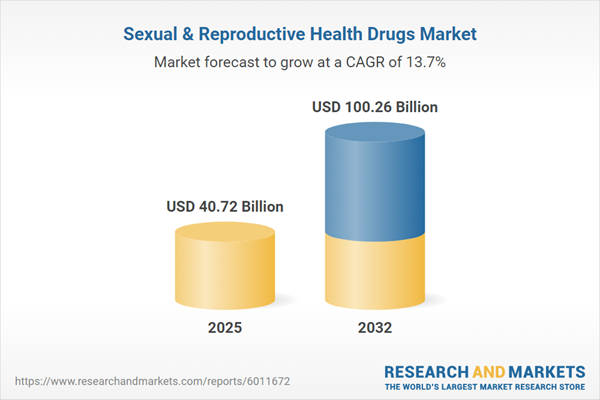Speak directly to the analyst to clarify any post sales queries you may have.
Senior executives in the sexual and reproductive health drugs market operate in a sector defined by rapid regulatory evolution and increased demand for innovative therapies. As the landscape shifts, organizations must navigate complex compliance requirements and adapt quickly to capture emerging growth opportunities while ensuring patient-centricity and operational resilience.
Market Snapshot: Sexual and Reproductive Health Drugs Market
The sexual and reproductive health drugs market demonstrates steady progression, with patient preferences driving continuous adaptations across pharmaceutical manufacturing and care delivery. Stakeholders now prioritize personalized therapies and advanced drug modalities, requiring companies to re-evaluate traditional business strategies and expand clinical options. Changing demographic patterns across global regions continue to shape both market demand and competitive positioning. For organizations seeking sustainable growth, responding to regulatory developments and reimbursement complexities, while optimizing operations, is fundamental. Leadership in this space is characterized by dynamic strategy, adaptability to diverse requirements, and proactive engagement across the healthcare value chain.
Scope & Segmentation of the Sexual and Reproductive Health Drugs Market
This executive summary defines the core segments influencing both commercial and clinical performance in the sexual and reproductive health drugs market. Structured segmentation aligns strategic investments and operational focus for optimal market impact.
- Drug Class: Includes contraceptives (oral, implantable, injectable, intrauterine), erectile dysfunction drugs, fertility treatments (such as GnRH analogues, ovulation inducers, gonadotropins), HIV prevention antiretrovirals, and hormonal therapies. Each class caters to distinct patient groups and clinical requirements.
- Mechanism of Action: Considers hormonal and non-hormonal mechanisms, presenting different challenges and opportunities for development, regulatory compliance, and market access strategies.
- Prescription Status: Covers prescription-only and over-the-counter options, influencing distribution models and potential for OTC growth in selected regions.
- Route of Administration: Addresses oral, injectable, topical, and transdermal solutions, shaping patient experience and promoting prescriber acceptance.
- Distribution Channel: Includes hospital pharmacies, retail stores, online platforms, and independent distributors, each demanding tailored logistics and outreach processes for broad market penetration.
- End User: Targets clinics, public and private hospitals, and home care environments, guiding service models and patient engagement strategies at each point of care.
- Geographical Regions: Segments cover North America, Latin America, Western and Eastern Europe, Middle East and Africa, and Asia-Pacific. Specific markets such as China, Japan, India, Australia, and Southeast Asia require region-specific commercial and regulatory approaches due to shifting demographics and evolving health policies.
- Key Companies: Highlights both established and emerging players, including Bayer AG, Pfizer Inc., Merck & Co., AbbVie Inc., Ferring B.V., Teva Pharmaceutical Industries Limited, Organon & Co., Gedeon Richter Plc, HRA Pharma SAS, and Eli Lilly and Company, each contributing to innovation and market expansion.
Key Takeaways: Strategic Insights for Senior Stakeholders
- Innovations in drug delivery and formulation have improved patient adherence and expanded reach to new demographic cohorts.
- Digital health integration, leveraging telemedicine and remote monitoring platforms, enhances patient engagement and medication management outside of traditional clinical environments.
- Organizations must adapt their structures and supply chains to respond effectively to evolving regulatory and reimbursement frameworks, reducing operational and market entry risks.
- Strategic collaborations between pharmaceutical firms, technology providers, and public health organizations accelerate geographic expansion and promote access in markets with growing demographic needs.
- Biomarker-driven therapies enable enhanced clinical differentiation, informing compliance and commercialization plans amid increasing global regulatory scrutiny.
Tariff Impact: Navigating U.S. Trade and Pricing Dynamics
U.S. tariff modifications have increased input costs for pharmaceutical manufacturers reliant on international supply chains. Executive teams are responding through supplier diversification and regionally focused procurement strategies. Proactive engagement with policymakers ensures operational continuity amid changing tariff landscapes, protecting enterprise resilience.
Methodology & Data Sources
The findings are informed by in-depth interviews with senior executives, expert panel consultations, regulatory reviews, and thorough market analysis. Additional validation comes from proprietary studies, peer-reviewed journals, and international trade data to support actionable guidance for decision-makers.
Why This Report Matters
- Enables senior decision-makers to allocate resources efficiently as market conditions and healthcare regulations evolve.
- Delivers well-structured intelligence spanning clinical, commercial, and operational domains, supporting informed and agile strategic planning.
- Prepares organizations to address regulatory, macroeconomic, and policy developments, ensuring business security and adaptability in a dynamic sector.
Conclusion
This report empowers senior leaders with actionable intelligence to drive strategic initiatives, mitigate risks, and identify emerging opportunities as the sexual and reproductive health drugs market continues to change.
Additional Product Information:
- Purchase of this report includes 1 year online access with quarterly updates.
- This report can be updated on request. Please contact our Customer Experience team using the Ask a Question widget on our website.
Table of Contents
3. Executive Summary
4. Market Overview
7. Cumulative Impact of Artificial Intelligence 2025
List of Figures
Companies Mentioned
The companies profiled in this Sexual & Reproductive Health Drugs market report include:- Bayer AG
- Pfizer Inc.
- Merck & Co., Inc.
- AbbVie Inc.
- Ferring B.V.
- Teva Pharmaceutical Industries Limited
- Organon & Co.
- Gedeon Richter PLC
- HRA Pharma SAS
- Eli Lilly and Company
Table Information
| Report Attribute | Details |
|---|---|
| No. of Pages | 196 |
| Published | November 2025 |
| Forecast Period | 2025 - 2032 |
| Estimated Market Value ( USD | $ 40.72 Billion |
| Forecasted Market Value ( USD | $ 100.26 Billion |
| Compound Annual Growth Rate | 13.7% |
| Regions Covered | Global |
| No. of Companies Mentioned | 11 |









